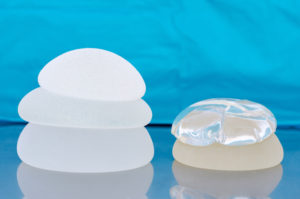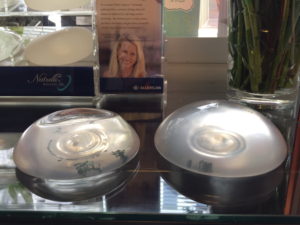What’s the difference between saline and silicone breast implants?
 Breast implant shells and dimensions
Breast implant shells and dimensions
All breast implants have a shell made out of an inert polymer called silicone, which is an inert (non-reactive) substance. Breast implant shell surfaces can be smooth or textured. Smooth walled implants roll around subtly in their breast pocket, mimicking movement of a natural breast, while textured implants encourage soft tissue ingrowth into their small surface interstices, keeping the implant more stiffly in place.
In my practice, I have always preferred smooth breast implants for aesthetic reasons. Now, there is a potential rare safety concern with textured implant surfaces. Keep reading to learn more…

There is not a “one size fits all” approach to breast augmentation. Breast implants have a variety of base widths, projection amounts and fill volumes. Some are wide and flat, others “middle of the road”, and still others very narrow with the most projection.
The best implant for each breast will be carefully selected and matched to the space to achieve the specific goals for that particular patient.
What are breast implants filled with?
Saline (sterile salt water)
Saline-filled implants are available to all women over the age of 18 years. Why age 18? That is the age of legal medical consent. An empty silicone shell is inserted into the body and then filled to its desired volume with saline fluid.
In my practice, I use saline breast implants most often for single-stage implant breast reconstruction. Smooth, round, permanent but postoperatively adjustable implants enable my patients to choose the final volume and results THEMSELVES. It is very empowering to women facing breast cancer!
Saline implants are GREAT for situations where we want the implant to remain adjustable after surgery – for instance, breast reconstruction or cases of a rare chest wall deformity such as Poland Syndrome. However, saline has the consistency of water, and has a higher incidence of seeing or feeling folds of the breast implant under very thin skin. This is known as “rippling” or “wrinkling”. Saline implants are usually not recommended as the best device for cosmetic breast augmentation for this reason.

Silicone gel (“gummy bear” implants)
Silicone gel is an inert polymer with no known human allergies, sensitivities or reactions. Just like a gummy bear, the silicone molecules are stuck to one another in a cohesive matrix that holds its shape more naturally than a saline filled device. Silicone is more “viscous” (has a thicker consistency) than saline.
In contrast to saline, silicone gel flows more slowly within the implant and creates a more natural look and feel to the breast. Women must be 22 years of age or older to be offered silicone gel implants for breast augmentation, as per the FDA’s regulations.
Why age 22 for silicone breast implants? Apparently, this is the age at which all breasts will have finished their growth and development, even if puberty was late or delayed for health reasons (such as a very low body weight).
 How have breast implants evolved since their inception?
How have breast implants evolved since their inception?
Created in the late 1960’s by two Dallas Plastic Surgeons, silicone gel implants were the first devices to be implanted. However, that wasn’t the first attempt at breast augmentation! There is a report of a surgeon in the 1900’s transplanting a lipoma (benign fat cell tumor) from a woman’s back to her breasts to attempt to increase its volume. However, because the blood supply was not intact, the fat did not survive.
Saline filled implants were created as an alternative to silicone fill and became popular in the 1990s and early 2000s. Since the first generation of breast implants, silicone gel implants have undergone several different minor modifications with technological improvements that are ongoing. Technology, research and development never stops!
Over the last 20 years, significant advances have been made to silicone gel implants. In fact, we are now have 7th and 8th generation silicone breast implants. The newest silicone implants have a slightly higher fill (96% fill versus the previous generation’s 85% fill) and different degrees of silicone cross- linking, altering the stiffness or “cohesiveness” of breast implants.
My favorite breast implant for augmentation is a smooth, round “responsive” silicone gel that moves with the body and looks and feels natural and soft. For breast reconstruction, a slightly stiffer implant is preferred because the breast tissue is gone and the implant will make up the whole shape of the breast. These implants are called “soft touch” (less stiff) and “highly cohesive” (most stiff).
What other variants of saline and silicone implants are currently available?
“Baffled” saline implants
A new generation of saline-filled breast implants were recently introduced as an alternative to silicone. “Baffling” refers to an internal channel structure within the implant, like layers on a shelf. Theoretically, these channels allow the saline inside to flow in different directions within the outer implant to simulate the feel of a silicone implant, with purported decreased incidence of rippling and sloshy liquid movement.
I still prefer silicone for all patients where we can insert the full-sized implant at the initial surgery – i.e. breast augmentation, implant exchange from the adjustable saline devices after mastectomy and Poland syndrome correction.
 How do we know breast implants are safe?
How do we know breast implants are safe?
Did you know – silicone gel breast implants are the most widely studied medical device in the history of medical devices? Historically, silicone gel implants received negative media attention and were sensationalized in the 1980s and 1990s, with apparent claims of adverse associated health problems, prompting removal and replacement of older silicone implants with saline filled devices.
Since that time, extensive FDA-directed prospective clinical research with long term follow up has confirmed no association between silicone gel implants and any chronic autoimmune disease. Read information from the ASPS about safety of breast implants and the potential association of textured implants with an extremely rare and treatable condition called BIA-ALCL.
For more information about breast augmentation, breast implant science and safety, visit other blog posts about breast implants on my website.
To schedule a consultation call 415-923-3067 or complete our online consultation request form today!

